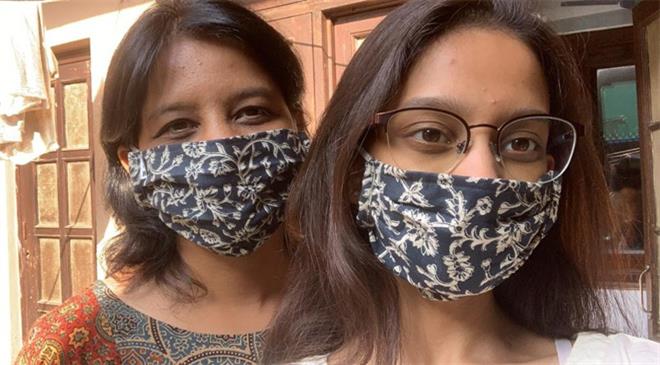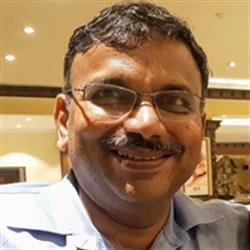'Project masks' business set to exceed garments by June '21
Next time you shop womenswear at Lifestyle, Aditya Birla Pantaloons, Big Bazaar and the like, chances are it would have been cut and stitched by a woman-strong team at Meemansa's Mumbai or Anand manufacturing units. Engaged in the manufacturing, trading and outsourcing of ready-made garments, apparels and accessories, the lockdowns triggered by the ongoing pandemic saw them diversify into face masks and plans are now afoot to launch their own products and even step into exports by January 2021. In an interview with Paulami Chatterjee, Manish Kothari, one of the founders, talks about the mask business, the company's continuous support towards various social initiatives and women-centric self-help groups.
How and when did Meemansa happen? What is the seed money with which it was started?
Meemansa started in December 2014 informally over a discussion between Manish Kothari and Priyanka Bapna. The seed money came in from the owners of Rhino Machines - Manish Kothari and Rashmi Kothari as majority partners, while Bapna took over the role of advisor-founder member.
What is the lead time needed to manufacture 1000 pieces?
The stitching production rate varies from 1 per hour or 10 per day for a medium complexity kurta to a 25 pants/day per machine. The lead time for a fresh order from fabric to stitching to despatch for 1000 pieces would be about 30 to 45 days.
Which are your major markets in India and abroad?
We are presently only in the private label space, supplying to the Indian chains. We are now exploring with masks to go overseas and have started our sampling and discussions. We expect to start working in the overseas market from FY 2021. We have been working on building our own brand.
How did the company grow eventually?
Meemansa inherited the legacy of business from Priyanka Bapna's previous business - working with business houses such as Westside, Lifestyle, Pantaloons, Max, Big Bazaar, Shoppers Stop and such other brands.
How big is the team of Meemansa today? What are the benefits of being a women rich team?
Meemansa has grown from a seed team of 5 persons - most of them continuing from their previous organisation of Priyanka Bapna and gone up to about 80 persons. Today it has added the stitching and manufacturing team and is about 100 persons in total, and may increase further as it starts in-house manufacturing. The key members at the top of the organisation starting from the owner - Rashmi, advisor - Priyanka, merchandisers, sales, accounting are women. Their understanding of garments and fabric, and high levels of empathy and commitment are very important for this product line.
From an indutva or ethnicwear producer, what prompted you to foray into masks?
The first step to masks was for the safety of our own staff, and therefore we made the masks in the second week of March when the Covid spread increased in Mumbai. When lockdown was announced, there were karigars who were stuck in Mumbai, and there was a demand for masks. We started to produce as a social cause and generate work and some income for the karigars stuck in the city.
When we found the IIT Bombay technology and were able to get the license, and we realised that the garment business is not likely to pick up for another 4 to 5 months, we decided to start making masks.
How did the collaboration with IIT Mumbai happen?
As we started distributing masks and selling the cloth masks, Priyanka and Pradeep (her husband) were researching and watching the news about the IIT technology. We wrote to them and we got a response, and then moved into a license agreement. The advantage was that Rhino Machines - our partner in Meemansa was at Anand and they opened up partially by April end, which allowed us to set up the processing facility with Rhino's R&D team led by Rajnikant Paghadar, get the sampling and testing done within 3 weeks. We also had our stitching unit and local karigars for producing, which helped us firm up the collaboration.

Which are the various women-centric self-help groups which are employed by Meemansa for their core product upcycling? Where are these groups located?
In 2017, Priyanka brought the thought of consuming the excess fabric and look at upcycling, which was experimented with Nivedita of Animedh Trust - Mumbai, and the project took good shape as it provided employment to underprivileged women. This experience of 1 year, led to make things more organised and we brought in GAP and Priyanka connected with iPartner to build relationships with NGOs through the groups, and few directly. The relationships were established directly with Self Help Groups (SHGs) under MoUs or informal agreements, and the location varied from Gulbarga - Karnataka, Tonk, Chittor, Udaipur - Rajasthan, Khajuraho - MP, Mumbai, Aurangabad & Nagpur - Maharashtra, Delhi and there is a proposal to work with 14 ACC Cement centres (CSR initiative by the corporate) in partnership with Head Held High (NGO) across India.

Approximately how many women do you provide employment to?
Each SHG would be about 10-15 women, and we have so far been connected with 10 such NGOs. We have touched the lives of about 100-150 women through the NGO network, and also employ about 25-30 women directly. We are now looking to employ another 50-100 women in Anand at our own manufacturing unit.
What is Duraprot technology all about? How do masks using this technology compare with other scientific masks which are available in the market?
Duraprot technology makes a cotton fabric self-disinfecting and being able to deactivate the SaRs-CoV2 virus and bacteria >99.99 per cent. This was tested in Intertek Laboratory at Mumbai (amidst the lockdown chaos). The other masks were only filtering but not deactivating the virus. The Duraprot Plus technology was tested in July 2020 and patented in September 2020, and the license was upgraded. The Duraprot Plus brought in the hydrophobic layer on top, which made the mask better than the N95. Duraprot Plus tests give >98 per cent filtration, splash resistance up to 140 mm hg, filters the virus < 1 PFU/ml - 3 basic properties of N95. It then exceeds the N95 as it also deactivates the virus and bacteria, is washable and has a 200 to 400 hours usage efficacy. All the tests done have been tabulated and shared in public domain.
The advantage of being a cotton fabric means it is bio-degradable, which in terms of sustainability is one of the biggest plus points. For a surgical mask which weighs 20 gm, and lasts 8 hours, every 100 days, 1 Duraprot mask is saving about 2kg of waste. This USP of being a cotton mask and being able to match or exceed the specifications available in the same category is the key differentiator.
Is masks now a major part of your revenue amidst the pandemic? What happened to the other garments you were producing for brands?
The masks have been a part of our revenue, but not major yet. We restarted our garments manufacturing though at one third the capacity from August, and continue our production of garments. We do project the masks business exceeding garments by June 2021, as we expand the business locally and globally.
How is the supply chain being worked out? Where do you source the raw materials from?
The key raw material is fabric which is sourced from suppliers in South India, Bhiwandi, Surat and such sources in bulk, dyed and printed at their end or in Bhiwandi / Mumbai as per our designs. The manufacturing or job work has been an outsourced model and at peak we engage about 500 stitching machines across 10 to 15 job workers. The fabric suppliers and job workers are the two important elements of our input supply chain.
Where does the production of garments take place? Do you have your own manufacturing facility or is the production outsourced to third-parties?
The manufacturing has been majorly outsourced. We began in Mumbai, worked in Jaipur, Ahmedabad and Vadodara. In Mumbai we partnered one of our job workers to set up our own manufacturing. During Covid this facility in Mumbai had to be closed down due to lack of manpower. Now since December 2019 we have started our own manufacturing at Anand with our host partner Rhino Machines Pvt Ltd.
What channels have you developed to sell your masks and other products?
We have been going through the B2C model - direct sales to customers, as the product is disruptive, more initial cost (even if the overall cost is much lower) and is going through a validation process. We are in discussions with a few large business houses, distribution partners to add our B2B channels. We are selling directly from our website, Amazon, Flipkart and also a very cute app Digital Dukaan from India through our own personal networks and media handles.
What steps are you taking for brand building?
We have engaged two reputed branding agencies and have also been using our social media handles managed directly by Manish Kothari, with feedback and posts about the market.

What is the production capacity of the units?
The capacity of our Anand unit is about 50 stitching machines and we plan to scale up to 200 stitching machines. Each machine produces about 10 to 12 garments/day/person. Normally the setups with whom we work have been between 10 to 50 machines and run by individuals with skilled karigars for stitching.

What are the top 5 requirements - beyond the givens of quality, time etc -to be able to sell to big stores?
The in-house design ability (our key USP), awareness of textile and design, cost competitiveness, OHSAS (SEDEX) Compliance, ISO 9001 - Quality Management Systems and own manufacturing facility are important.
What are the future plans for the company? Any future collaborations in pipeline?
We are completing our ISO 9001:2015 certification, followed by ISO 13485 (for masks) and then C E Marking. We have already registered the masks as a medical device on Indian CDSCO (Central Drug Standards Control Organisation). With our QMS in place, we shall be able to set up global sales directly or through partners in these regions.
Our plans are dual - one in the masks which will be used for medical as well as industrial use, build our new quality facility at Anand, set up a comprehensive training digital platform to onboard NGOs in different parts of the country and be ready to absorb demand, be open to work with larger established players and partner them in this product line. (PC)
What are the disadvantages of selling to these stores?
The volumes are high, but margins are wafer thin, the cost of failure is high. The cycles are very short and the final delivery pressures are high. Too high dependence on a single store or group is a big risk in business.
You are catering to some of the best stores in the country. Any plans to launch your own brand in the market?
We have been working on building our own brand. We started a year ago with upcycled products, and during Covid, the mask business allowed us to experiment with our own brand and move from B2B model to B2C - our first such venture, and it has given us confidence to launch our own product lines from January 1, 2021, which are as follows:
1. Womenswear- kaftans, kurtas, kurtis
2. Menswear - shorts, kurtas
3. Unisex shirts and shorts
4. Bags, upholstery & such accessories





